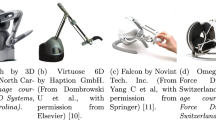Abstract
Prostate Brachytherapy is the implantation of radioactive seeds into the prostate as a treatment for prostate cancer. The success rate of the procedure is directly related to the physician’s level of experience. In addition, minor deviations in seed alignment caused by gland compression/retraction, gland edema (swelling) and needle deflections can create significant areas of over or under dosage to the gland and/or injury to surrounding nerves and organs, leading to increased morbidity. Therefore, reductions in brachytherapy complication rates will be dependent on improving the tools physicians use for training to improve the accuracy of needle guidance and deployment of ‘seeds’ within the prostate gland. Through our novel approach of using two C-ARM fluoroscopes, we propose a reality-based approach for estimating needle and soft tissue interaction for the purpose of eventually developing an accurate seed placement training simulator with haptic feedback for prostate brachytherapy. By recording implanted fiducial movement and needle-soft tissue interaction forces, we can: extract the local effective modulus during puncture events, quantify tissue deformation, obtain an approximate cutting force, and build a finite element model to provide accurate haptic feedback in the training simulator for needle insertion tasks.
This work was supported in part by National Science Foundation CAREER award IIS 0133471, NSF ITR award 0312709, and Beukenkamp Foundation.
Access this chapter
Tax calculation will be finalised at checkout
Purchases are for personal use only
Preview
Unable to display preview. Download preview PDF.
Similar content being viewed by others
References
R. Alterovitz, R. Pouliot, R. Taschereau, I. Hsu and K. Goldberg (2003) Simulating Needle Insertion and Radioactive Seed Implantation for Prostate Brachytherapy. Medicine Meets Virtual Reality 11, 19–25
P. N. Brett, A. J. Harrison and T. A. Thomas (2000) Schemes for the Identification of Tissue Types and Boundaries at the Tool Point for Surgical Needles. IEEE Transactions on Information Technology in Biomedicine, 30–36
R. A. Cormack, C. M. Tempany and A. V. D’Amico (2000) Optimizing Target Coverage by Dosimetric Feedback During Prostate Brachytherapy. International Journal of Radiation Oncology Biology and Physics, 484: 1245–1249
S. P. DiMaio and S. Salcudean (2002) Needle insertion modeling and simulation. IEEE International Conference on Robotics and Automation, 2098–2105
C. Forest, H. Delingette and N. Ayache (2002) Cutting Simulation of Manifold Volumetric Meshes. Proceedings of the Fifth International Conference on Medical Image Computing and Computer Assisted Intervention, 2 235–244
J. D. Hall (2003) Why patients choose prostatectomy or brachytherapy for localized prostate cancer: results of a descriptive survey. Urology, 61 402–407
J. Hong, T. Dohi, M. Hashizume, K. Konishi and N. Hata (2004) An Ultrasound-driven needle-insertion robot for percutaneous cholecystomy. Physics in Medicine and Biology, 49 441–455
A. Jemal (2004) Cancer Statistics. CA Cancer J. Clin, 54 8–29
H. Kataoka, T. Washio, K. Chinzei, K. Mizuhara, C. Simone and A. Okamura (2002) Measurement of Tip and Friction Force Acting on a Needle During Penetration. Proceedings of the Fifth International Conference on Medical Image Computing and Computer Assisted Intervention, 216–223
S. E. Langley and R. W. Laing (2004) Iodine seed prostate brachytherapy: an alternative first-line choice for early prostate cancer. Prostate Cancer Prostatic. Dis., 7 201–207
B. Leak (2002) Relavent patient and tumor considerations for early prostate cancer treatment. 39–44
J. Magill, B. Anderson, G. Anderson, P. Hess and S. Pratt (2004) Multi-Axis Mechanical Simulator for Epidural Needle Insertion. International Symposium on Medical Simulation
H. Nienhuys and F. van der Stappen (2003) Interactive needle insertions in 3D nonlinear material.
M. D. O’Leary, C. Simone, T. Washio, K. Yoshinaka and A. M. Okamura (2003) Robotic Needle Insertion: Effects of Friction and Needle Geometry. IEEE International Conference on Robotics and Automation
G. Picinbono, H. Delingette and N. Ayache (2001) Nonlinear and anisotropic elastic soft tissue models for medical simulation. IEEE International Conference on Robotics and Automation, 1370–1375
L. Potters (2003) Permanent prostate brachytherapy in men with clinically localized prostate cancer. Clinical Oncology, 15 301–315
J. Sharkey (2000) Minimally invasive treatment for localized adenocarcinoma of the prostate: review of 1048 patients treated with ultrasound-guided palladium-103 brachytherapy. Journal of Endourology, 14 343–350
C. Simone and A. Okamura (2002) Modeling of Needle Insertion Forces for Robot-Assisted Percutaneous Therapy. IEEE International Conference on Robotics and Automation, 2085–2091
W. L. Smith, K. Surry, G. Mills, D. Downy and A. Fenster (2001) Three Dimensional Ultrasound-Guided Core Needle Breast Biopsy. Ultrasound in Medicine and Biology, 278: 1025–1034
D. Stoianovici, L. Whitcomb, J. Anderson, R. Taylor and L. Kavoussi (1998) A Modular Surgical Robotic System for Image Guided Percutaneous Procedures. MICCAI, 404–410
Author information
Authors and Affiliations
Corresponding author
Editor information
Editors and Affiliations
Rights and permissions
Copyright information
© 2007 Springer-Verlag Berlin Heidelberg
About this paper
Cite this paper
Hing, J.T., Brooks, A.D., Desai, J.P. (2007). Reality-Based Estimation of Needle and Soft-Tissue Interaction for Accurate Haptic Feedback in Prostate Brachytherapy Simulation. In: Thrun, S., Brooks, R., Durrant-Whyte, H. (eds) Robotics Research. Springer Tracts in Advanced Robotics, vol 28. Springer, Berlin, Heidelberg. https://doi.org/10.1007/978-3-540-48113-3_4
Download citation
DOI: https://doi.org/10.1007/978-3-540-48113-3_4
Publisher Name: Springer, Berlin, Heidelberg
Print ISBN: 978-3-540-48110-2
Online ISBN: 978-3-540-48113-3
eBook Packages: EngineeringEngineering (R0)




